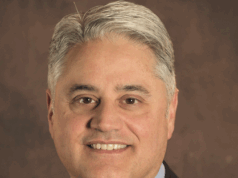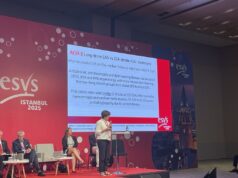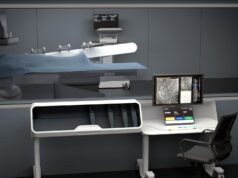 Preliminary results from the STEP (Stroke from thoracic endovascular procedures) registry show that silent brain infarction following endovascular repair of the aortic arch is frequent, with postoperative diffusion weighted magnetic resonance imaging (DW-MRI) demonstrating an incidence of 50%.
Preliminary results from the STEP (Stroke from thoracic endovascular procedures) registry show that silent brain infarction following endovascular repair of the aortic arch is frequent, with postoperative diffusion weighted magnetic resonance imaging (DW-MRI) demonstrating an incidence of 50%.
As a result of this main finding, Philippe Charbonneau (Hôpital Marie Lannelongue, GHPSJ, Paris, France) and colleagues write in an online European Journal of Vascular and Endovascular Surgery (EJVES) article that “innovative strategies to reduce the risk of embolisation need to be developed”.
The authors begin: “Over the last decade, thoracic endovascular aortic repair (TEVAR) has supplanted open surgery as the main repair technique for aneurysms of the descending thoracic aorta”. While TEVAR has an “early morbidity and mortality advantage,” they note, neurological complications following TEVAR remain a “significant periprocedural concern”.
Charbonneau and colleagues explain that cerebral solid and gaseous embolisation during aortic arch instrumentation is “debated to be the primary cause of perioperative stroke and silent brain infarction.” They note that silent infarct is defined as “image proven ischaemic brain injury without acute neurological dysfunction attributable to the lesion” and detail that it is identified as “an independent predictor of future stroke, cognitive impairment, and dementia”.
Considering the literature, the authors write that only a few studies have investigated the presence of silent brain infarction following TEVAR using cerebral DW-MRI, showing lesions in up to 81% of patients within the first week after TEVAR involving the aortic arch.
Addressing the need for data on carbon dioxide flushing
Charbonneau et al state that use of carbon dioxide flushing to replace trapped air in stent graft delivery systems has been introduced to reduce gaseous embolisation during TEVAR, but that “its impact on silent brain infarction has not yet been evaluated with cerebral imaging”.
According to the authors, the STEP registry is the largest study to evaluate the incidence and distribution of silent cerebral infraction following endovascular repair for disease of the aortic arch, and also the first cohort to include total endovascular arch repair and devices flushed with carbon dioxide.
The purpose of this work, Charbonneau and colleagues relay, was to quantify silent brain infarction in a patient population that underwent advanced endovascular aortic arch treatment. They specify that the study included total endovascular arch repairs, and carbon dioxide flushed devices as one embolic protection strategy.
Writing in EJVES, Charbonneau and colleagues detail that this multicentre retrospective cohort study included consecutive patients treated with an aortic endoprosthesis deployed in Ishimaru zone 0–3 and brain DW-MRI within seven days following the procedure. They state that DW-MRI was performed to identify the location and number of new silent brain infarctions and that all endografts were flushed with carbon dioxide prior to implantation.
A total of 91 patients (mean age, 69 years; men, 64%) were included in the study. The authors relay that these patients were from two academic centres and were treated between September 2018 and January 2020, adding that the procedure was elective in 71 patients (78%).
In terms of aortic pathology, Charbonneau et al detail that treatment was performed for a dissection, degenerative aneurysm, or other aortic disease in 44 (49%), 34 (37%), and 13 (14%) patients, respectively.
Finally, the authors specify that endografts were deployed in zone 0, 1, 2, or 3 in 23 (25%), 10 (11%), 47 (52%), and 11 (12%) patients, respectively. They detail that endografts were branched (25%), fenestrated (17%), or tubular (58%).
Key findings: No deaths or clinical strokes, but frequent silent brain infarctions
At 30 days, Charbonneau and colleagues report that there were no deaths or clinical strokes. However, on cerebral DW-MRI, they identified a total of 245 silent brain infarctions in 45 patients (50%). They specify that lesions were in the left hemisphere in 63% of the patients (153/245), predominantly in the middle territory (94/245).
On univariable analysis, the investigators identified some factors that were “significantly associated” with the presence of silent brain infarction, including deployment in zone 0–1 (p=0.026), placement of a branched or fenestrated endograft (p=0.038), a proximal endoprosthesis diameter ≥40mm (p=0.038), and an urgent procedure (p=0.005). They add that urgent procedure was found to be an independent predictor on multivariable analysis (binary logistic regression; p=0.002).
Results limited by selection bias, undetected strokes, and follow-up period
Charbonneau et al acknowledge some limitations of this retrospective study. For example, they recognise a selection bias in that the study cohort included non-consecutive patients who underwent TEVAR, and that two patients from the total population of nearly 100 patients who experienced ischaemic stroke during the study period were excluded from analysis, as the DW-MRI was not performed within the appropriate time window.
In addition, they note that specific neurocognitive examinations were not performed, meaning that “cognitive impairment cannot be judged,” and add that postoperative clinical evaluation was not routinely done with a neurologist, which “may have resulted in undetected relevant strokes”. Finally, they highlight that follow-up ended at 30 days following the repair.
Charbonneau and colleagues conclude that silent brain infarction is a common finding after endovascular arch repair, particularly in urgent procedures. They reiterate that this study is the largest cohort of patients evaluated by cerebral DW-MRI for the incidence of silent brain infarction following endovascular repair for disease of the aortic arch including total endovascular arch repair, and carbon dioxide flushed devices.
“Considering the long-term cognitive effect of silent brain infarction described in the literature,” they posit, “efforts should continue to identify and validate associated factors”. Also, they stress that “novel embolic protection strategies need to be developed to decrease the occurrence of those lesions”.
Cause of brain damage after TEVAR “too often accepted as fate”
Vascular News spoke to co-author Tilo Kölbel (University Heart and Vascular Centre, Hamburg, Germany), who commented on the significance of these results: “Stroke after TEVAR is the most feared complication risk of this otherwise game-changing minimally invasive treatment for thoracic aortic pathologies. The cause of stroke and other less obvious brain-damage such as silent brain infarction is meanwhile not sufficiently studied and too often accepted as fate due to our lack of knowledge. We have for too long focused solely on the advantages of endovascular aortic techniques, encouraged by the superior results compared to open surgery.
“This blindness towards disadvantages and risks of new exciting technology is not surprising and normal human behaviour, but may prove a disservice to the endovascular and catheter-based revolution in cardiovascular therapy. Changing our research focus early towards the potential drawbacks of TEVAR, such as cerebral damage caused by the solid and gaseous embolisation, will eventually strengthen the technique as it will enable us to make progress and find new protective measures to improve our results.
“Carbon dioxide flushing is a low-risk technique to reduce air embolisation from TEVAR devices used in leading aortic centres. Charbonneau et al present here a first proof of the potential efficacy of carbon dioxide flushing: in this high-risk selection of arch TEVAR cases, there is a lower rate of silent brain infarction (50%) compared with what has been reported so far for lower-risk procedures (80%). We see an increasing interest in this important research topic and look forward to see improved technology and devices in order to minimise the collateral damage of endovascular arch repair.”
Co-author Fiona Rohlffs (University Hospital Hamburg-Eppendorf, Hamburg, Germany) also remarked on the findings, noting that the incidence of silent brain infarctions “could be associated with loss of cognitive function in the long-term, and therefore represents a major concern for the patient”. However, she noted that neurocognitive function tests “may provide more information, and the study demonstrates a need to focus on this aspect”.
Rohlffs added: “By using DW-MRI we have a diagnostic tool to visualise the harm to the brain and to observe techniques to potentially lower the risk of embolisation to the brain. Of course, it is a first analysis but it might be also a first STEP to improve the outcomes of TEVAR as is draws attention to this problem.”













